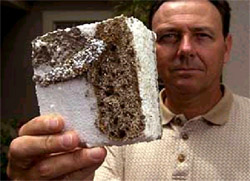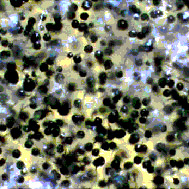| Mold: Introduction for Insurance Agents | ||||
|
||||
|
|
||||
|
What is mold? Mold facts Ever find mold around your home? Not a pleasant discovery. Homeowners view it with a mixture of disgust and worry. But what exactly is mold?
There are more than 100,000 identified species of mold. At least 1000 species of mold are common in the US. Some forms of molds produce toxins, called mycotoxins, which are found in both living and dead spores. About 100 of these species are linked to possible human illness/disease. There are two main categories of molds: Some common molds include the following: What is Stachybotrys? Have you heard about Stachybotrys chartarum? Well, this is a mold that every agent should get to know (from a safe distance!!).
The mycotoxins produced by Stachybotrys are extremely toxic, potentially carcinogenic and immunosupressive. Stachybotrys is a long-term growth mold and is often found in conjunction with other molds, such as Aspergillus. This mold chooses a host of building materials such as: Requirements for mold growth In order for mold to grow, it requires the right combination of moisture, oxygen, darkness, nutrients, and proper temperature. Think hidden water pipes and other susceptible areas around the home. Moisure With sufficient exposure to moisure, spores start multiplying within 72 hours (depending on the strain of mold). Stachybotrys needs a little longer exposure to the right conditions and high levels of humidity (94%+). Oxygen Mold cannot grow without oxygen. Nutrients Cellulose material is the primary food source for mold. Nutrients for mold can be found in almost every building. They include the following: Temperature Depending on the mold, the temperature needs to be between 40-100 F. How do molds affect people? The U. S. National Center for Disease Control (CDC) has stated that they do not believe that anyone needs to take any different precautions with Stachybotrys chartarum than with preventing the growth of any other mold species. There is a surprising lack of scientific knowledge about the proven dangers that molds may present; the many claims being made are the subject of great controversy. No scientific studies have been performed to date that establish a direct relationship between mold contamination and health impacts. As a result, no doctor or health official can establish what levels of mold are safe or unsafe in a home, school or office building. Currently there are no Federal regulations for evaluating potential health effects of fungal contamination and remediation. Dr. Quade Stahl, the Director of the Indoor Air Quality division of the Texas Department of Health stated that there are over a thousand different mycotoxins that various molds produce and there is no way to determine the health effects on people and "it is impossible to set any type of standards." Testing for mold There are several methods currently being used to test for mold: Where are molds found? It is not just found in your brother's sock drawer or that sandwich that been sitting a few days too long in the refrigerator; mold is found in virtually every environment and can be detected outdoors and indoors year round. Mold growth is encouraged by warm and humid conditions. Outdoors they can be found in shady, damp areas or places where leaves or other vegetation is decomposing. Indoors they can be found where humidity levels are high, such as basements or showers. The following occupancies are at high risk for mold exposure: Increasing problems with mold Modern construction has more enclosed spaces, and this results in breeding more mold. This is known as the Tight Building Syndrome. People spend up to 90% of their time indoors which creates an almost constant exposure to indoor elements. The term Sick Building Syndrome is used to describe situations in which building occupants experience acute health and comfort effects that appear to be linked to time spent in a building, but no specific illness or cause can be identified. The complaints may be localized in a particular room or zone, or may be widespread throughout the building. In contrast, the term Building Related Illness is used when symptoms of diagnosable illness are identified and can be attributed directly to airborne building contaminants. Reactions to mold exposure Some people are allergic to mold. Exposure to molds can cause symptoms such as nasal stuffiness, eye irritation, wheezing, or more serious reactions. More aggravated reactions, such as fever and shortness of breath, may occur among workers exposed to large amounts of molds in occupational settings, such as farmers working around moldy hay. People with chronic illnesses, such as obstructive lung disease, may develop mold infections in their lungs. Other severe symptoms of mold exposure include pulmonary hemorrhage, lung scarring, and brain damage. High-risk occupants include the following: |
||||
|
Next Page >
|
||||
|
| ||||
|
© Copyright CEfreedom.com and Insurance Skills Center. All Rights Reserved. |
||||
|
Not only are policy forms, clauses, rules and court decisions constantly changing, but forms vary from company to company and state to state. This material is intended as a general guideline and might not apply to a specific situation. The authors, LunchTimeCE, Inc., CEfreedom, and Insurance Skills Center, and any organization for whom this course is administered will have neither liability nor responsibility to any person or entity with respect to any loss or damage alleged to be caused directly or indirectly as a result of information contained in this course.
|

